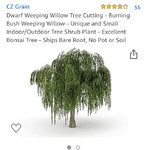PlantsAndPaws
Seedling
- Messages
- 9
- Reaction score
- 3
Hello everyone! My name is Laura, and I’m happy I found this site, for I am a beginner and have some questions. Sometimes YouTube videos and google can be very overwhelming and not really addressing my specific questions. So my question to you is, what do I do with this willow??!! Although I have a few baby plants that I’ve grown from seed, I’m new to willows. I acquired a willow trimming that has grown quick in the past 6 months and I just don’t know what to do with it. Any and all suggestions and guidance is greatly appreciated. Thank you in advance!






